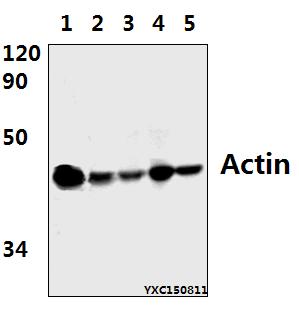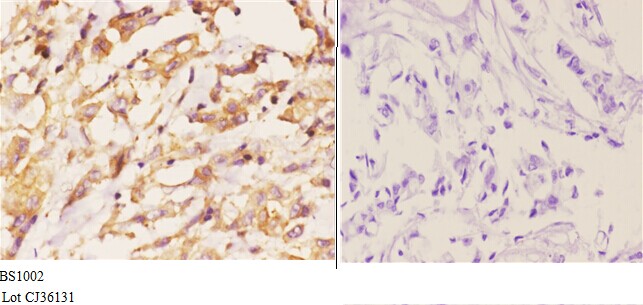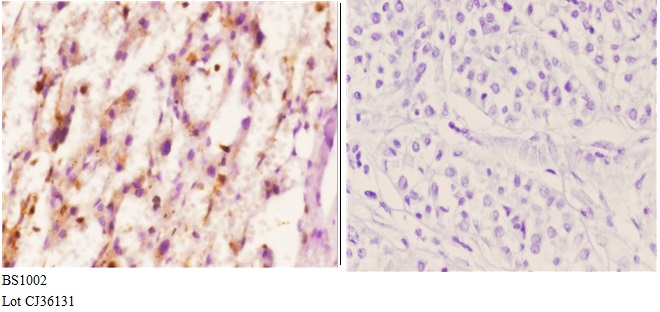Product Name :
Actin (E361) polyclonal antibody Background :
All eukaryotic cells express Actin, which often constitutes as much as 50% of total cellular protein. Actin filaments can form both stable and labile structures and are crucial components of microvilli and the contractile apparatus of muscle cells. While lower eukaryotes, such as yeast, have only one Actin gene, higher eukaryotes have several isoforms encoded by a family of genes. At least six types of Actin are present in mammalian tissues and fall into three classes. Alpha Actin expression is limited to various types of muscle, whereas beta and gamma are the principle constituents of filaments in other tissues. Members of the small GTPase family regulate the organization of the Actin cytoskeleton. Rho controls the assembly of Actin stress fibers and focal adhesion, Rac regulates Actin filament accumulation at the plasma membrane and Cdc42 stimulates formation of filopodia. Product :
Rabbit IgG, 1mg/ml in PBS with 0.02% sodium azide, 50% glycerol, pH7.2 Storage&Stability :
Store at 4°C short term. Aliquot and store at -20°C long term. Avoid freeze-thaw cycles. Specificity :
Actin (E361) polyclonal antibody detects endogenous levels of Actin protein. Immunogen :
Synthetic peptide, corresponding to amino acids C-terminus of Human Actin. Conjugate :
Unconjugated Modification :
Unmodification
Actin (E361) polyclonal antibody Background :
All eukaryotic cells express Actin, which often constitutes as much as 50% of total cellular protein. Actin filaments can form both stable and labile structures and are crucial components of microvilli and the contractile apparatus of muscle cells. While lower eukaryotes, such as yeast, have only one Actin gene, higher eukaryotes have several isoforms encoded by a family of genes. At least six types of Actin are present in mammalian tissues and fall into three classes. Alpha Actin expression is limited to various types of muscle, whereas beta and gamma are the principle constituents of filaments in other tissues. Members of the small GTPase family regulate the organization of the Actin cytoskeleton. Rho controls the assembly of Actin stress fibers and focal adhesion, Rac regulates Actin filament accumulation at the plasma membrane and Cdc42 stimulates formation of filopodia. Product :
Rabbit IgG, 1mg/ml in PBS with 0.02% sodium azide, 50% glycerol, pH7.2 Storage&Stability :
Store at 4°C short term. Aliquot and store at -20°C long term. Avoid freeze-thaw cycles. Specificity :
Actin (E361) polyclonal antibody detects endogenous levels of Actin protein. Immunogen :
Synthetic peptide, corresponding to amino acids C-terminus of Human Actin. Conjugate :
Unconjugated Modification :
Unmodification
-
 Western blot (WB) analysis of Actin (E361) polyclonal antibody at 1:500 dillution Lane1:Hela whole cell lysate(40μg) Lane2:HEK293T whole cell lysate(40μg) Lane3:NIH-3T3 whole cell lysate(40μg) Lane4:RAW264.7 whole cell lysate(40μg) Lane5:PC12 whole cell lysate(40μg)
Western blot (WB) analysis of Actin (E361) polyclonal antibody at 1:500 dillution Lane1:Hela whole cell lysate(40μg) Lane2:HEK293T whole cell lysate(40μg) Lane3:NIH-3T3 whole cell lysate(40μg) Lane4:RAW264.7 whole cell lysate(40μg) Lane5:PC12 whole cell lysate(40μg) -
 Immunohistochemistry (IHC) analyzes of Actin (E361) pAb in paraffin-embedded human breast carcinoma tissue at 1:50.showing cytoplasmic and cytoskeleton staining. Negative control (the right)Using PBS instead of primary antibody, secondary antibody is Goat Anti-Rabbit IgG-biotin followed by avidin-peroxidase.
Immunohistochemistry (IHC) analyzes of Actin (E361) pAb in paraffin-embedded human breast carcinoma tissue at 1:50.showing cytoplasmic and cytoskeleton staining. Negative control (the right)Using PBS instead of primary antibody, secondary antibody is Goat Anti-Rabbit IgG-biotin followed by avidin-peroxidase. -
 Immunohistochemistry (IHC) analyzes of Actin (E361) pAb in paraffin-embedded human breast carcinoma tissue at 1:50.showing cytoplasmic and cytoskeleton staining. Negative control (the right)Using PBS instead of primary antibody, secondary antibody is Goat Anti-Rabbit IgG-biotin followed by avidin-peroxidase.
Immunohistochemistry (IHC) analyzes of Actin (E361) pAb in paraffin-embedded human breast carcinoma tissue at 1:50.showing cytoplasmic and cytoskeleton staining. Negative control (the right)Using PBS instead of primary antibody, secondary antibody is Goat Anti-Rabbit IgG-biotin followed by avidin-peroxidase.
Chromatin collapse during caspase-dependent apoptotic cell death requires DFF40/CAD-mediated 3'-OH single-strand DNA breaks
PMCID: Pubmed No.:23430749
Mineral trioxide aggregate upregulates odonto/osteogenic capacity of bone marrow stromal cells from craniofacial bones via JNK and ERK MAPK signalling pathways
PMCID: Pubmed No.:24635197
Peroxiredoxin 6 attenuates ischemia‑and hypoxia‑induced liver damage of brain‑dead donors
PMCID: Pubmed No.:26647763
Resveratrol protects mice from paraquat-induced lung injury: The important role of SIRT1 and NRF2 antioxidant pathways
PMCID: Pubmed No.:26708779
Peroxiredoxin 6 attenuates ischemia‑and hypoxia‑induced liver damage of brain‑dead donors
PMCID: Pubmed No.:26647763
Resveratrol protects mice from paraquat-induced lung injury: The important role of SIRT1 and NRF2 antioxidant pathways
PMCID: Pubmed No.:26708779
Mineral trioxide aggregate upregulates odonto/osteogenic capacity of bone marrow stromal cells from craniofacial bones via JNK and ERK MAPK signalling pathways
PMCID: Pubmed No.:24635197
Involvement of calmodulin in regulation of primary root elongation by N-3-oxo-hexanoyl homoserine lactone in Arabidopsis thaliana
PMCID: Pubmed No.:25628641
Methylation of DACT2 promotes breast cancer development by activating Wnt signaling
PMCID: Pubmed No.:28607412
Differential drug resistance acquisition to doxorubicin and paclitaxel in breast cancer cells
PMCID: Pubmed No.:25550688
Short hairpin RNA silencing of TGF-βRII and FZD-7 synergistically suppresses proliferation and metastasis of hepatocellular carcinoma cells
PMCID: Pubmed No.:26998118
Peroxiredoxin 6 attenuates ischemia‑ and hypoxia‑induced liver damage of brain‑dead donors
PMCID: Pubmed No.:26647763
Resveratrol protects mice from paraquat-induced lung injury: The important role of SIRT1 and NRF2 antioxidant pathways
PMCID: Pubmed No.:26708779
Crucial role of serum response factor in renal tubular epithelial cell epithelial-mesenchymal transition in hyperuricemic nephropathy
PMCID: Pubmed No.:31774735
Biological effect of ribosomal protein L32 on human breast cancer cell behavior
PMCID: Pubmed No.:32705264
Serum response factor increases renal cell carcinoma migration and invasion through promoting epithelial–mesenchymal transition
PMCID: Pubmed No.:32524697
Clinical significance of ring finger protein 2 high expression in skin squamous cell carcinoma
PMCID: Pubmed No.:32724350
Oncogenic TRIB2 interacts with and regulates PKM2 to promote aerobic glycolysis and lung cancer cell procession
PMCID: Pubmed No.:35790734
LncRNA-84277 is involved in chronic pain-related depressive behaviors through miR-128-3p/SIRT1 axis in central amygdala
PMCID: Pubmed No.:35959106
Effect of Probiotic Fungi against Cognitive Impairment in Mice via Regulation of the Fungal Microbiota–Gut–Brain Axis
PMCID: Pubmed No.:35833673
Semaglutide Protects against 6-OHDA Toxicity by Enhancing Autophagy and Inhibiting Oxidative Stress
PMCID: Pubmed No.:35873704
Hippocampus-prefrontal cortex inputs modulate spatial learning and memory in a mouse model of sepsis induced by cecal ligation puncture
PMCID: Pubmed No.:36377471
Maternal circadian disruption before pregnancy impairs the ovarian function of female offspring in mice
PMCID: Pubmed No.:36572306
Halofuginone ameliorates systemic lupus erythematosus by targeting Blk in myeloid-derived suppressor cells
PMCID: Pubmed No.:36493694
The functional link between TCTP and Drsl1 in deltamethrin-stressed Drosophila Kc cells
PMCID: Pubmed No.:36464172
Neuroprotective effect of hyperoside in MPP+/MPTP -induced dopaminergic neurodegeneration
PMCID: Pubmed No.:36576692
Small Molecule Compound K-7174 Attenuates Neuropsychiatric Manifestations in Lupus-prone Mice
PMCID: Pubmed No.:36521514
Increased Expression of the p-STAT3/IL-17 Signaling pathway in patients with Dermatomyositis
PMCID: Pubmed No.:36478263
Baicalin Nanocomplexes with an In Situ-Forming Biomimetic Gel Implant for Repair of Calvarial Bone Defects via Localized Sclerostin Inhibition
PMCID: Pubmed No.:36753285
Cytoplasmic localization of IRF5 induces Wnt5a/E-cadherin degradation and promotes gastric cancer cells metastasis
PMCID: Pubmed No.:36782048
MiR-146a-5p Contributes to Microglial Polarization Transitions Associated With AGEs
PMCID: Pubmed No.:36780120
DIFFERENTIATED EMBRYONIC CHONDROCYTE EXPRESSED GENE-1 IS A CENTRAL SIGNALING COMPONENT IN THE DEVELOPMENT OF COLLAGEN-INDUCED RHEUMATOID ARTHRITIS
PMCID: Pubmed No.:36739947
Reduction of NADPH oxidase 4 in adipocytes contributes to the anti-obesity effect of dihydroartemisinin
PMCID: Pubmed No.:36915539
Propolis Ethanolic Extract Attenuates D-gal-induced C2C12 Cell Injury by Modulating Nrf2/HO-1 and p38/p53 Signaling Pathways
PMCID: Pubmed No.:37047379
Improved targeting delivery of WED-load immunoliposomes modified with SP-A mAb for the treatment of pulmonary fibrosis
PMCID: Pubmed No.:36871414
MTH1 protects platelet mitochondria from oxidative damage and regulates platelet function and thrombosis
PMCID: Pubmed No.:37563135
Melatonin alleviates intrarenal CaOx crystals deposition through inhibiting LPS-induced non-canonical inflammasome-mediated renal tubular epithelial cells pyroptosis
PMCID: Pubmed No.:37633237
Targeting SDCBP2 in acute myeloid leukemia
PMCID: Pubmed No.:37714445
Resveratrol ameliorates diabetic encephalopathy through PDE4D/PKA/Drp1 signaling
PMCID: Pubmed No.:37722608
Simvastatin ameliorates synaptic plasticity impairment in chronic mild stress-induced depressed mice by modulating hippocampal NMDA receptor
PMCID: Pubmed No.:37715015
Brassica oleracea L. extract ameliorates isoproterenol-induced myocardial injury by regulating HIF-1α-mediated glycolysis
PMCID: Pubmed No.:37907131
Bioworld Biotech only provide peptides for our antibodies and do not provide additional peptide customization services.
Price/Size :
USD 368/1mg/vial
Tips:
For phospho antibody, we provide phospho peptide(0.5mg) and non-phospho peptide(0.5mg).Describe :
Blocking peptides are peptides that bind specifically to the target antibody and block antibody binding. These peptide usually contains the epitope recognized by the antibody. Antibodies bound to the blocking peptide no longer bind to the epitope on the target protein. This mechanism is useful when non-specific binding is an issue, for example, in Western blotting (WB) and Immunohistochemistry (IHC). By comparing the staining from the blocked antibody versus the antibody alone, one can see which staining is specific; Specific binding will be absent from the western blot or IHC performed with the neutralized antibody.Formula:
Synthetic peptide was lyophilized with 100% acetonitrile and is supplied as a powder. Reconstitute with 0.1 ml DI water for a final concentration of 10 mg/ml.The purity is >90%,tested by HPLC and MS.
Storage:
The freeze-dried powder is more stable. For short time at 2-8°C. For long term storage store at -20°C.
Note :
This product is for research use only (RUO only). Not for use in diagnostic or therapeutic procedures.
 Actin (E361) polyclonal antibody
Actin (E361) polyclonal antibody  Datasheet
Datasheet COA
COA MSDS
MSDS SHIP
SHIP